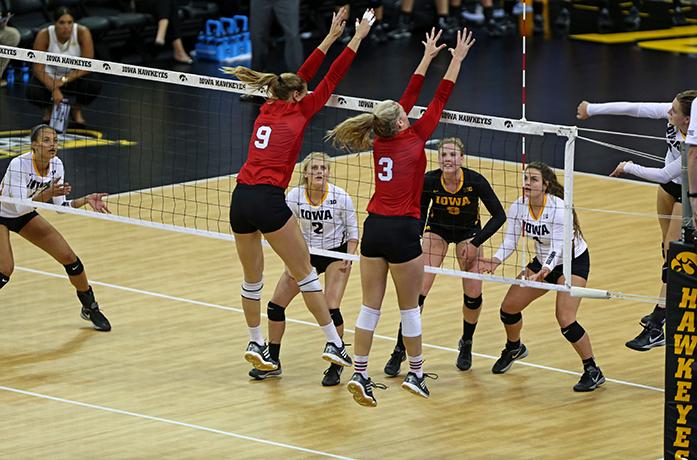The Hawkeyes were up-ended by No. 4 Nebraska and its strong blockers.
By Kyle Mann
[email protected]
The Iowa volleyball team opened Big Ten play with two losses against No. 4 Nebraska on Sept. 23 and 26, and despite being very competitive for five of the six sets, it has some obvious points of improvement.
The Hawkeyes gained immensely from the experience against top-flight competition, but they could also take a few pointers from the Huskers.
The Iowa offense enjoyed many spurts of dominance, particularly in the first match in Carver-Hawkeye, but each time was eventually thwarted by Nebraska’s strong defense at the net.
“They made the adjustment of being cleaner up on the block,” Loxley Keala said after the Sept. 23 loss at home. “We were getting seams and holes and even one-on-ones with Lauren [Brobst], and I think they realized she had the hot hand. They did a great job of adjusting their block and their defense to what was working for us.”
The teams ended up with equal block numbers (6) in the first match, but somehow, it was Nebraska’s that seemed to have more effect. While Iowa followed with 6 in the second match, Nebraska’s defense was again noted as a game changer.
The Cornhuskers finished with 10 team blocks, and Hawkeye head coach Bond Shymansky believes that their 5 blocks in the first set had a effect for the remainder of the match.
“They started blocking us a lot early, and when you get blocked as a hitter, it makes you think a lot about where you need to hit the next ball,” Shymansky said. “You don’t want to be in thinking mode, you just want to be in doing mode.”
What he describes could be observed in the home match on Sept. 23.
Where early in the match Brobst and Jess Janota were able to let loose and have free swings for kills, a Nebraska time-out with the Hawkeyes up 17-10 changed things. When the Huskers adjusted their blockers as Keala said, Brobst, Janota, and Reagan Davey could be seen going up and deciding in midair to opt for a finesse sort of teardrop to go over the blocks rather than forcefully go through them.
While the Hawkeyes have now seen and felt the effects of an effective defense at the net, they likely would like to revamp their own.
The Hawkeyes have a much improved offense but are third-to-last in the Big Ten in blocks with only 1.94 per set. That is perfectly reflected in the fact that they also allow the third-highest hitting percentage by opponents and also surrender the third-most kills by opponents.
Shymansky will certainly look to get his defense up to par if the Hawkeyes hope to be an upper-tier team in the Big Ten, but as far as counteracting other strong defenses around the conference, his offensive system is designed to get teams off balance.
Things went largely as could have been expected in the first week of Big Ten play. The Hawkeyes looked vastly improved against top competition, but the No. 4 team in the country, as it should, prevailed. Nonetheless, Iowa will be better for its firsthand lesson in the disruptiveness of a strong block and its room to improve in attacking one.
“We run more of a fast offense, so we’re trying to counteract the big, physical, skilled players,” Janota said. “Our quickness and the tempo of our sets help us in that regard.”
Follow @KyleFMann on Twitter for Iowa volleyball news, analysis, and updates.



